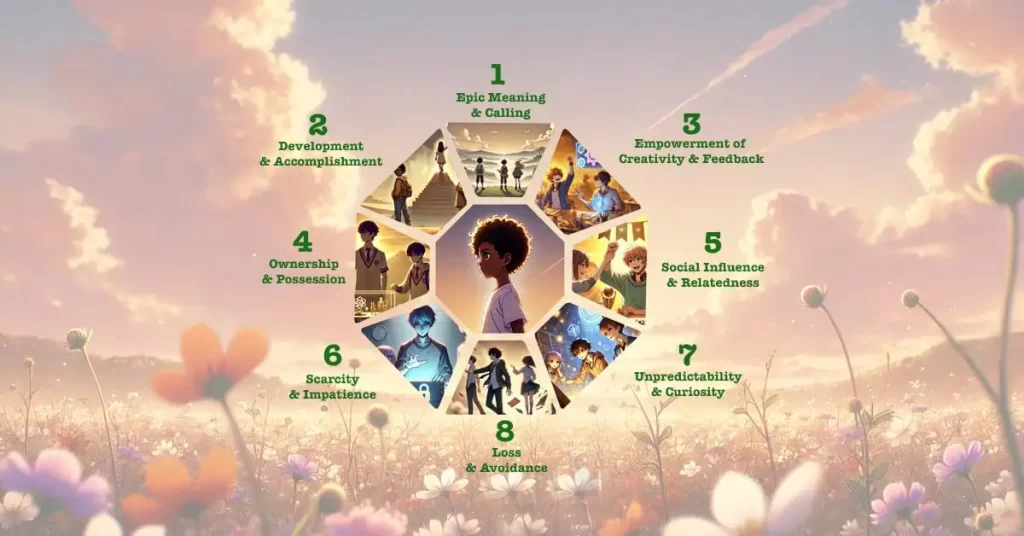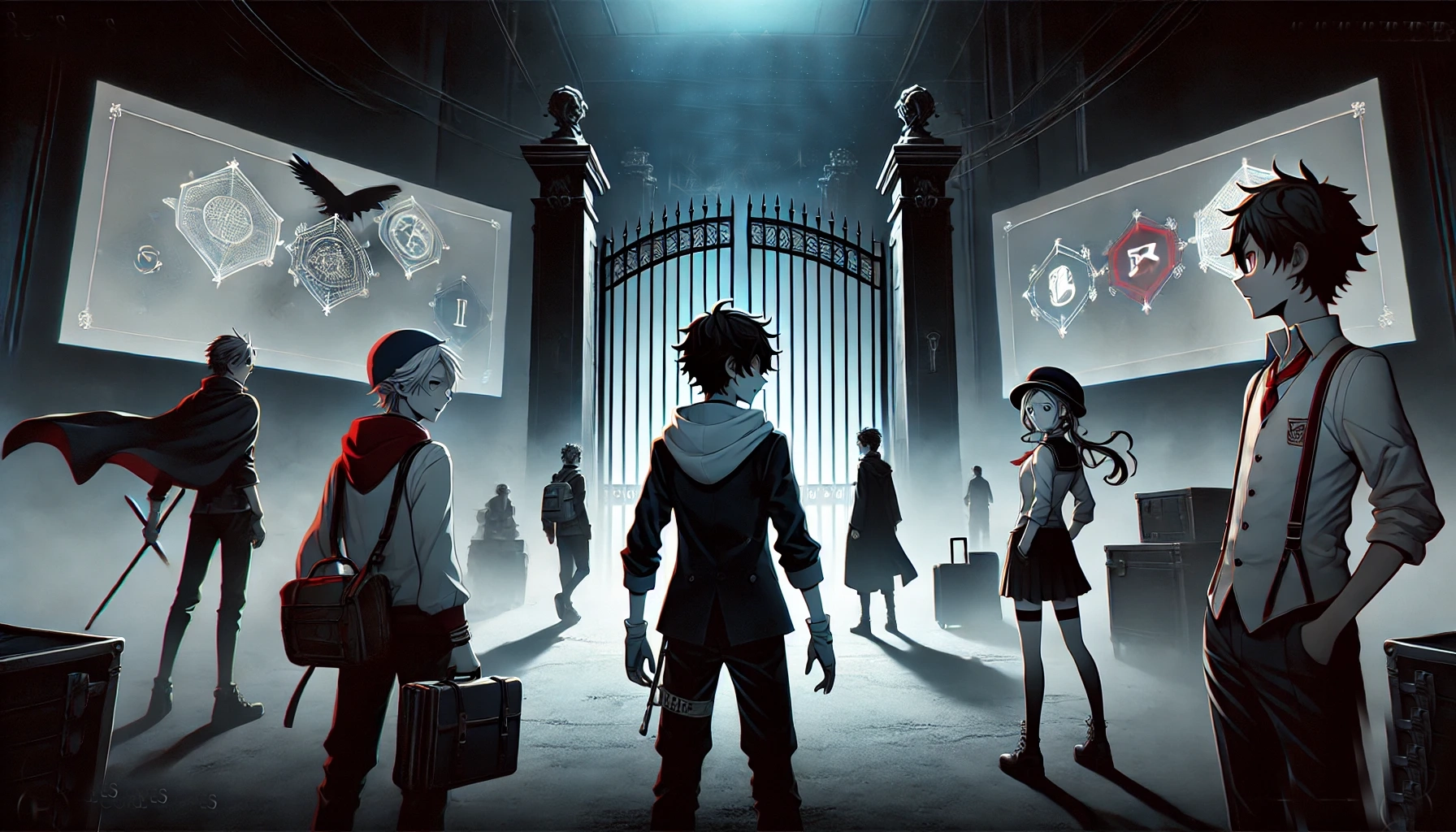Octalysis Framework Black Hat Core Drives
Motivating students isn’t as simple as dangling a carrot. In learning, that carrot sometimes needs a sharp edge. Octalysis Framework Black Hat Core Drives focus on urgency, unpredictability, and the fear of failure, tapping into the human psyche in ways that push students forward. While these drives can feel risky, when paired thoughtfully with White Hat like purpose or mastery, they can spark engagement in ways traditional teaching methods often miss.
Think about those moments when students light up with curiosity or push themselves because they don’t want to fall behind. This is where educational Gamification becomes more than just a buzzword and starts to speak to every type of learning style. It’s not about manipulation, it’s about understanding what makes people tick. And in the process, it equips students with tools not only to stay engaged but to thrive.
Use these insights: urgency, unpredictability, and the pull to succeed, to enhance your classroom strategies. When applied carefully, they weave into a reward system that changes the game, keeping students motivated and ready to learn. If this piques your interest, there’s more to uncover about Gamification’s role in modern education, and exploring beyond just the core drives could open up even greater opportunities.
This post is part of a series! Explore the entire Octalysis Framework and see how it can help you motivate your students. (Don’t let the FOMO pull you away, there is another link at the bottom of this post!)
Quest Map
Breaking Down Black Hat Motivation
When it comes to educational Gamification with the Octalysis Framework, understanding Black Hat Core Drives is essential. These are the motivators that push us—not with warm encouragement but by tugging on our instincts for survival, our curiosity, and our fear of missing out. It’s a kind of motivation that might feel intense, even uncomfortable, but it’s undeniably effective when handled with care. Let’s take a closer look at three key areas under Black Hat motivation.
Scarcity & Impatience: Driving Urgency Through Limits
Nothing gets the heart racing like knowing there’s a limited window of opportunity to succeed. Scarcity is a powerful motivator, especially in educational settings. It taps into the fear of missing something valuable—whether it’s knowledge, achievements, or recognition. Impatience takes that tension and elevates it, pushing learners to act now rather than later.
Think about offering a quiz or challenge with a strict deadline. It creates a sense of urgency because the opportunity won’t wait forever. But remember, it’s not just about setting limits; it’s also about balancing fairness. If students feel like they’re constantly on edge, the positive drive can spiral into frustration. However, when well-aligned with a reward system, this technique inspires quicker decisions and sharper focus.

Unpredictability & Curiosity: Capturing Attention by Keeping It Unknown
Imagine playing a game where you never know what surprise awaits around the next corner. That feeling of “What’s next?” is exactly what unpredictability and curiosity bring into the learning process. When students can’t predict the next lesson or outcome, their attention locks in. It’s like unlocking a digital treasure chest, you can’t resist checking what’s inside.
A simple way to integrate this is through mystery challenges or by withholding certain details of a project until later steps reveal themselves. Students remain motivated because the unexpected keeps them guessing and striving to discover more. Curiosity doesn’t just make learning enjoyable; it builds anticipation, which can re-ignite engagement in even the most difficult topics.
To learn more about crafting curiosity using the Octalysis Framework, you might find this resource helpful.
Loss & Avoidance: The Fear of Loss as a Motivator
Avoidance is a little different from other motivators because it pulls rather than pushes. This drive thrives on the fear of losing something valuable, whether it’s a grade, a reward, or a peer’s respect. It may sound harsh, but when used carefully, it can be a potent tool in keeping students on track.
For example, penalizing late work with minor grade deductions isn’t just about discipline; it teaches responsibility. Fear of failure or lagging behind sparks a survival response, it’s almost primal. Still, tread cautiously. Overuse can lead to stress or anxiety, so it’s important to pair avoidance techniques with reassurance and support.
Incorporating scarcity, unpredictability, and avoidance into your Gamification strategies can feel like walking a tightrope. It’s not about manipulating students but giving them structured challenges that amplify their drive to succeed. If you’d like deeper insights into how these Core Drives function, check out The Octalysis Framework for Gamification.

Why Black Hat Motivation Can Be Effective (When Used Carefully)
When we talk about educational Gamification, Octalysis Framework Black Hat Core Drives often get a bad rap. It’s easy to associate it with fear, pressure, or even manipulation. But when used thoughtfully, it becomes less of a loaded gun and more of a sharp tool, one that can shape motivation in powerful and sometimes surprising ways.
This isn’t about scaring students into submission; it’s about understanding what keeps people engaged at their core and using that insight as a way to address different learning styles and challenges. Let’s break down why Black Hat motivators can sometimes work wonders—when applied with a delicate touch.
The Power Behind Controlled Urgency
Sometimes, urgency is exactly what people need. Think about it—how many of us procrastinate until there’s a deadline staring us in the face? A pinch of pressure can work like adrenaline, focusing attention and driving action. In education, this type of motivation can be as simple as setting time-sensitive challenges or countdowns to spark effort.
Take, for instance, a student debate where preparation must happen in 24 hours. When the clock visibly ticks, it creates an atmosphere that encourages action without dragging on. But here’s the caution: too much urgency can lead to burnout or anxiety. It’s all about balance, using pressure to inspire a sense of accomplishment rather than stress.
Learn more about handling urgency in design by exploring Black Hat Gamification Design.
Fear of Loss as a Wake-Up Call
Loss is a funny thing. Nobody wants to lose, whether it’s something tangible, like a grade, or intangible, like respect among peers. The avoidance of loss can be a powerful motivator, particularly during points where engagement might be naturally low.
Picture this: students are given virtual tokens or points at the beginning of a module. Late assignments or skipped participation might mean a slight deduction, but the tokens lost build over time, impacting their cumulative “reward system.” It’s not just punishment; it’s a way to nudge responsibility. This approach can foster reflection, students see how their choices directly impact rewards and incentives.
To avoid misuse, always pair this technique with encouragement and clear paths toward “winning back” what’s lost. It’s not about punishing students but offering structured opportunities to improve and recover.

The Unexpected Keeps Motivation Alive
We’ve all felt the pull of unpredictability. Whether it’s unwrapping a mystery gift or wondering what’s inside a locked chest in a game, unpredictability triggers curiosity. Learning taps into this drive beautifully when designed with surprises that keep students attentive and intrigued.
Imagine starting a lesson with a question: “What’s the one thing Albert Einstein failed at during school?” You don’t immediately spill the answer but break it into a sequence, rewarding students with parts of the answer as they hit different milestones through the lesson. This constant state of wonder keeps students invested and excited to go further.
Understanding when and how to layer unpredictability without creating distraction can be an art. Here’s an insightful guide on integrating unpredictability with Black Hat Gamification.
Why Being Careful Matters
Octalysis Framework Black Hat motivation isn’t inherently “bad,” but it demands precision. Overdoing urgency can make students freeze instead of act. Leaning too heavily on loss triggers anxiety instead of responsibility. And excess unpredictability might become a distraction rather than a motivator. It’s a delicate balance, but when done right, it aligns with the natural ways we’re wired to think, feel, and act.
If you’re interested in diving deeper into topics like this, be sure to join my email list. I’ll share more strategies and behind-the-scenes insights for using Gamification to make meaningful connections with your learners.

The Three Octalysis Framework Black Hat Core Drives for K-12 Classrooms
Black Hat motivation might sound alarming at first, but when woven into your classroom strategies with intention and care, it transforms into a tool that sharpens engagement. At its heart, it’s not about manipulation—it’s about understanding how urgency, unpredictability, and a touch of pressure can ignite focus and spark motivation. Let’s unpack how these drives play out specifically in K-12 classrooms and how you might safely integrate them into your educational approach.
⏳ Octalysis Framework Core Drive 6: Scarcity & Impatience
Have you ever noticed how students perk up when they know something’s a “limited-time opportunity”? Scarcity taps into the deep-seated human instinct to act now before it’s too late. Incorporating elements of scarcity in education, such as time-sensitive activities, once-a-week contests, or exclusive privileges, can light a fire under even the most distracted learners.
For instance:
- Time-limited quizzes: Create a 10-minute pop-quiz session where students can earn bonus points. It’s short, sweet, and laser-focused.
- Limited availability perks: Offer a chance for the top three performers in a month to pick their preferred team members on group projects.
- Exclusive content reveals: Schedule “unlockable” lessons or hints that require students to hit certain milestones.
However, there’s a fine line between making it exciting and making it stressful. If students feel constant pressure, engagement quickly morphs into anxiety. Always build in breathing room. Offer additional opportunities for those who might miss out, and present scarcity-centered activities as a reward rather than a punishment.
➡️ Read more about Core Drive 6: Scarcity & Impatience
🌀 Octalysis Framework Core Drive 7: Unpredictability & Curiosity
Unpredictability adds an element of surprise that keeps students hooked. Think of it as a spark plug in your everyday routines. There’s something irresistible about the unknown that fuels curiosity. When students don’t know what’s coming, they lean in, paying closer attention to anticipate the next move. Remember playing a board game as a kid and hanging on every dice roll? That same magic applies here.
Classroom ideas to implement:
- Mystery challenges: Start lessons with a sealed envelope containing surprise group tasks or riddles.
- Random reward systems: Provide a spinning reward wheel for participation points. Students love the anticipation.
- Unscheduled pop-events: Throw a “Surprise Experiment Friday” or “Wildcard Wednesday” every once in a while.
But use this sparingly. Routine still has its place in teaching. Overusing unpredictability can leave students feeling off-balance rather than inspired. Keep surprises light-hearted and celebratory, ensuring they remain a bonus rather than a stressor.
➡️ Read more about Core Drive 7: Unpredictability & Curiosity
🕳️ Octalysis Framework Core Drive 8: Loss & Avoidance
The fear of loss might not sound positive, but let’s be honest: it works. Nobody wants to lose an edge, whether it’s a top grade or a cool privilege like extra recess time. When used thoughtfully, avoidance motivates students to stay on track by emphasizing the consequences of procrastination or negligence.
Ways to apply avoidance strategies:
- Deadline-based practices: Incrementally deduct points for late assignments while allowing recovery options (e.g., extra credit).
- Exclusive privileges: Reserve high-tech gadgets or activities for students who meet specific behavioral or academic goals.
- Personalized reflection: Create a system where students self-assess their missed deadlines and “pay it forward” by assisting peers on future tasks.
The key is reframing avoidance positively. Instead of focusing solely on the negative consequence (like losing points), emphasize what students can earn or maintain when they meet expectations, such as retaining privileges. Never let these measures feel punitive without offering redemption options. It’s about growth, not punishment.
➡️ Read more about Core Drive 8: Loss & Avoidance
Wrapping Up
Black Hat Core Drives can feel like sneaky motivators, but when used thoughtfully, they serve as powerful tools for short-term classroom engagement. Scarcity sparks urgency, unpredictability keeps curiosity alive, and avoidance makes accountability stick. These strategies aren’t about creating fear. They’re about gently nudging students to discover their limits and break through them.
Before you dive into incorporating these elements, take a moment to reflect. Think about one way you could add a touch of controlled unpredictability or create a time-bound challenge that inspires action in your lessons. Could it be a surprise project reveal? Or maybe a countdown quiz? Start small and always build on feedback.
If this got you thinking, the next post will explore the exciting world of Right Brain Core Drives. Those motivators rooted in creativity and desire. To stay updated and get exclusive tips, join the email list. It’s a space for sharing ideas that make learning vibrant and meaningful. Let’s keep growing together.
Want to explore more ways to motivate your students with Octalysis Framework?
Visit the Ultimate Guide to Octalysis Framework.
This comprehensive guide provides an overview of the entire framework and links out to more posts exactly like this one to guide you through all 8 Octalysis Framework Core Drives and even more!




🎮 Octalysis Framework Black Hat Core Drives
What are Black Hat Core Drives in the Octalysis Framework?
Black Hat Core Drives are motivators based on urgency, scarcity, unpredictability, and avoidance of loss. They tap into fear-of-missing-out energy and create high-stakes moments that push learners into action. When used responsibly, they’re super effective for short-term motivation (but no, they’re not evil).
Aren’t these strategies manipulative?
They can be, if you overdo it. But when you combine them with White Hat motivators like purpose and creativity, you get a balanced system that motivates without overwhelming. Think of Black Hat drives like hot sauce: just enough adds zing, too much ruins the dish.
How do I use Octalysis Framework Black Hat motivation without stressing out my students?
Use it sparingly and strategically. For example:
Add timed challenges to increase urgency.
Use mystery tasks to build curiosity.
Introduce mild penalties for missed deadlines, but always offer redemption.
The key is pairing pressure with support and safety nets.
Do these techniques work for all grade levels?
Yep, with adjustments. Younger students respond well to playful countdowns or surprise tasks, while older students and adult learners appreciate challenge-based urgency or point systems tied to accountability. Just match the intensity to the age and emotional maturity of your learners.
Where can I learn more about combining Octalysis Framework Black Hat and White Hat motivators?
Start with this guide on White Hat vs. Black Hat Gamification. You’ll learn how to balance pressure and purpose to create classroom systems that motivate, challenge, and support all at once.






